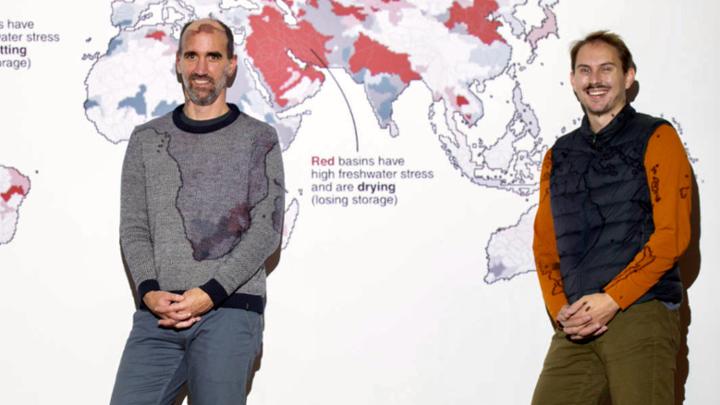Global hotspots mapped out in new water study
April 28, 2022

Xander Huggins (right) maps vulnerability in the world’s freshwater basins with the help of his UVic PhD supervisor, Tom Gleeson (left), an expert in groundwater research.
Research led by a UVic PhD candidate identified the priority of 168 water basin “hotspots” in efforts to achieve future freshwater sustainability for the planet.
Xander Huggins has analyzed freshwater basins around the world to better understand the impact of hydrologic change on human and ecological systems. The research, which was recently published in Nature Communications, identifies the basins that are most at risk to experience societal and ecological impacts due to freshwater stress and storage loss.
“Found on every continent, these basins represent the epicenters of potential system-wide issues,” says Xander, who is working on a PhD at both UVic Civil Engineering and the University of Saskatchewan’s Global Institute for Water Security.
“Understanding the potential for social and ecological impacts from freshwater stress and storage loss at the global scale is important in informing prioritization within international sustainability initiatives, such as the UN Sustainable Development Goals.”
The 168 hotspot basins identified encompass more than 1.5 billion people, 17 per cent of global food crop production, 13 per cent of the global gross domestic product and hundreds of wetlands designated as internationally important.
The research paper notes that there are substantial social and ecological benefits to reducing vulnerability in hotspot basins, achieved through diplomacy, capacity building and integrated water resources management practices. Some of the most vulnerable basins are those that cross international borders, especially in Eastern Africa and Southern Asia.
In places where water tables are dropping and wells are at risk of running dry, groundwater access may intensify social inequalities, as only the wealthy may be able to afford to drill deeper wells. Such conditions may trigger conflict and have implications on international security.
The study used the best available global hydrological, socio-hydrological and eco-hydrological datasets to map the basins that are most vulnerable to freshwater stress and storage loss. Huggins says this work presents an alternative approach to guide prioritization of water resource sustainability initiatives, informed by system-wide vulnerability of impacts rather than guided by water resource trends on their own.
Freshwater stress is the ratio of freshwater withdrawal to streamflow, while freshwater storage is the vertical sum of groundwater, soil moisture, surface water and snow water equivalent storages. Freshwater storage becomes a required source of water during periods when demands exceed supply, though this study was the first to compare the two at the global scale.
Read Hotspots for social and ecological impacts from freshwater stress and storage loss in Nature Communications.
